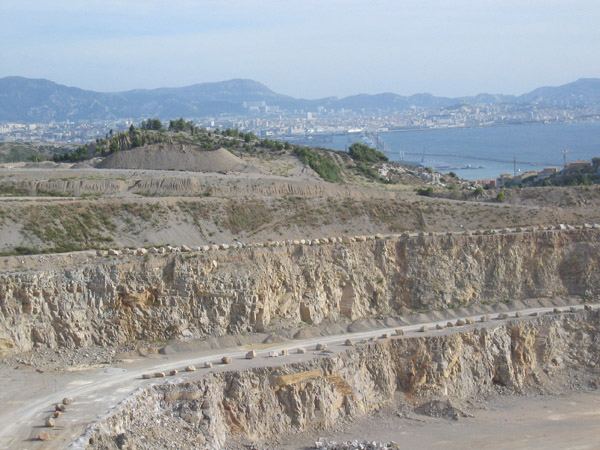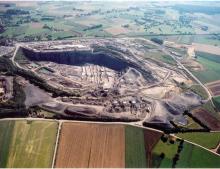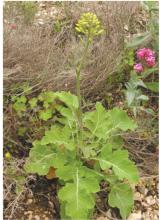
Achieving environmental excellence in today's aggregate extraction will help ensure access to mineral resources in the future, according to
Balancing different land uses means that biodiversity and sustainability have become hot topics in Europe's quarrying sector over the last decade and are likely to remain at the forefront of the industry. Recent research and new understanding means that some companies in the industry are not just talking about the environment but can actually prove their credentials in this area.
Lafarge prides itself in being one of the leaders on this front and has set itself a number of strategic targets to drive continual improvement. The company's chairman Bruno Lafont has spelled this out clearly by placing rehabilitation of quarries and implementation of biodiversity at the same level of critical importance across the group as reducing carbon dioxide emissions One of the key developments within the group has been Lafarge's biodiversity index, which is being used to quantify and qualify the biodiversity of the sites. The system gives quarries a score of one to seven based on the rarity of the species identified and the surface area of the natural environment. The ratings will underpin the company's action programme and allow it to benchmark its site and review progress accurately.
The scheme is being put through its paces in Lafarge's UK, Spanish, German and French quarries but the plan is to roll the system out to the rest of the company's 900 quarries worldwide.
In France, Arnaud Colson is the man charged with the responsibility of delivering this strategy and developing it for the local market to give the maximum effect. He is vice president for public affairs and sustainable development for Lafarge Aggregates and Concrete in France - a business that includes 150 quarries and 300 ready mixed concrete plants.
A passion for the natural landscape combined with nearly 30 years of experience working in the quarrying sector has given Colson the ideal background for this role. He started out in his career as an agricultural engineer working on land management projects and joined Lafarge in 1979 to help overcome specific planning problems during restoration of a large quarry in Normandy.
Once the Normandy project was successfully completed, he stayed with the company and has been instrumental in helping to develop Lafarge's approach to sustainability and biodiversity in France. "The focus on rehabilitation is what I enjoy - the ability to create new spaces that are both useful for society and beneficial to the environment," he said.
Targets
From this year Colson will also be drawing on the knowledge of a new expert panel recently set up by Lafarge. The company brought together an international panel of scientists to work with Lafarge and the World Wildlife Fund for Nature (WWF) to carry out research on sustainability and biodiversity and provide advice.
The group will be directly involved in helping to shape policies within Lafarge to achieve its environment and biodiversity aims set out under Ambitions 2012.
Objectives set out for its quarrying business include having all sites environmentally audited in the last four years - the company has currently achieved this at 84% of its global operations. Also by 2010 it plans to have all of its quarries screened to criteria validated by the WWF and have a rehabilitation plan, which complies with Lafarge standards, in place at least in 85% of its sites.
The company has also set itself challenges for the cement division with cuts of 20% in carbon dioxide (compared to 1990 levels) by 2010 and significant reductions in dust, nitrous oxide and sulphur oxide emissions.
French focus
While Lafarge has group targets, it is up to each country to find its own solution to meet these as there is no one size fits all policy when it comes to biodiversity, according to Colson. "Even within one country the ecology and habitats will vary more than the geology does, so it is important to have a flexible approach that can be applied on a site by site basis and not in a heavy handed way," he said.
"In the past there was a lot of difficulty in implementing environmental policies but over the last 20 years, the tools available to the sector have significantly increased. Twenty years ago it was not possible to envisage the capabilities that now exist to re-create habitats and environments and to demonstrate that the quarry industry has a positive contribution to make to the environment.
"In France we are developing a biodiversity strategy to focus on key sites where the biodiversity has been impacted by quarrying activity. When these sites have been identified we are working to implement a quarry-specific plan that is in line with the size and location of the operation to reverse the impact." Colson's aim is to have a biodiversity management programme in place by 2012 for any of Lafarge's French quarries which is shown to have altered the natural environment.
"Reversing the impact may be as simple as improving conditions for one species of animal, bird or plant but it could extend to re-establishing a whole ecology," he said. "Regular biodiversity audits are underway and will be repeated on a four year cycle to ensure that any change is for the positive, and take action if any negative impacts are shown." Research is also being carried out in France into wetland ecology. "We have been very successful at recreating wetland habitats but we want scientific proof of our capabilities," said Colson. "We are also working on a project with the Museum of Natural History in France to extend our understanding." Although Colson is passionate about biodiversity, he said that it is only one element of overall quarry rehabilitation. "The reclamation process needs to be planned right from the start of a quarry to give the best overall impact - considering the transportation, quarry management and overall environmental plan in a joined up process is important," he said.
While Colson's position for Lafarge Aggregates and Concrete is France-focused, he also chairs the
"The quarrying industry needs to work with policy makers both at the national level and also at the European level to ensure we have long term access to mineral resources. My role with the UEPG is to underline the importance of the aggregates sector, not just to the economy from providing over 250,000 jobs but also to explain that without mineral resources development and maintenance, Europe will grind to a halt." Part of that has involved Colson in organising trips to quarries so that members of the
The UEPG is also working with the EC's Directorate General for Environment and Enterprise on agreeing sustainability development indicators for the industry. "These indicators will help the industry to prove that it is not working against the environment but can work with nature," said Colson.
His vision is to have European-wide laws that not only protect access to mineral resources but also plans for the restoration and sets out standards. "It is a big challenge in the European context because the industry is already constrained by a lot of complex legislation," he said. "But the benefit of these laws is that the European sector already has better environmental standards than exist elsewhere." According to Colson, while demonstrating the good environmental credentials to Europe's policy makers is a step in the right direction, there is still a real problem with the public's 'not in my backyard' attitude towards quarries. "Most residents don't want to see the landscape change and we need to work to help them understand the positive effect that quarries can bring in terms of improving biodiversity, controlling flooding and providing new drinking water sources," he said.
"There is an urban mentality across Europe which has influenced this. Around 80% of the population in France are urban dwellers, whereas 20 to 30 years ago it was more like 50%. The urban view is that the landscape should be unchanged and, while quarrying can have a positive impact, it is on a different timescale to public perception. Quarry restoration may not be completed until 20 or 30 years after the rock is first extracted but the public wants to see the benefit from the changes almost immediately."
Stewardship
According to Colson, taking biodiversity and quarry rehabilitation seriously is very important as he firmly believes that access to future mineral resources will be judged based on current activities and practices.
Nonetheless, while many around Europe bemoan the time it takes to gain a license to extract from a new resource, Colson believes that this extension is important for the environment. "It used to take a year to gain permission for a new quarry in France," he said. "Today, it could be three, five or even seven years but the extra time means that the impact on the environment and local ecology can be fully considered.
"This allows for a solution to retain and improve the biodiversity to be developed with the cooperation of all the stakeholders and ensures the best interests of all concerned are considered. However, this kind of process and time period is only appropriate for long term extraction agreements, which allow for meaningful rehabilitation and allow us to invest."










